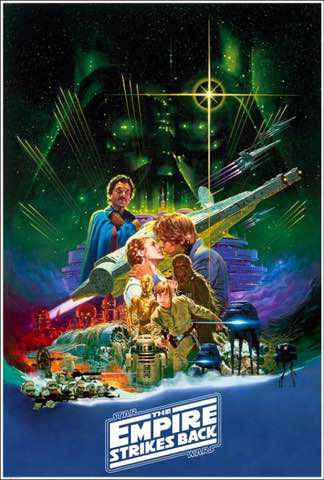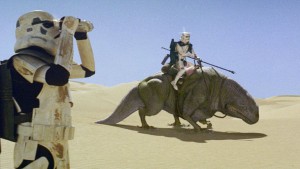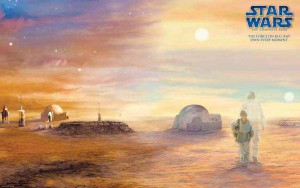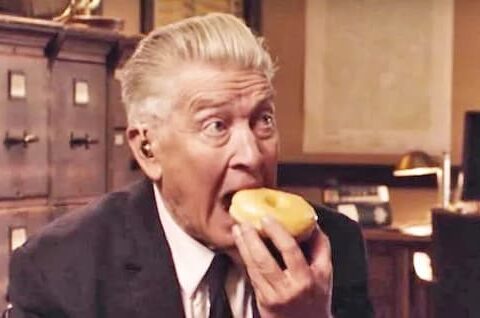Star Wars “purists” who’ve for a long time been waiting for Lucasfilm to re-release the original, unaltered versions of the first Star Wars Trilogy may soon get their wish
At least according to Comicbook.com, which cites two independent sources suggesting Disney/Lucasfilm is planning such a release for the near future.
Whether this rumoured re-release of the Original Trilogy in unaltered form will go ahead or not, it does reignite the old debate among fans as to whether the original untouched versions or the revised special-edition versions are the superior statements; and moreover the debate as to which versions should be considered the ‘definitive’ versions of the Original Star Wars Trilogy.
This contentious question has never bothered me as much as it has bothered other people, as I still have all of my original VHS releases of the Original (Unaltered) Trilogy; as well as the Special Edition VHS releases, and the Revised Revised DVD additions from 2004.
And… in truth, most of the changes or additions made to these films have been okay by me (with one or two exceptions, which I’ll highlight).
But which iteration of these movies is ‘better’?


Despite having began my love affair with George Lucas’s great space opera at the age of about six in the mid-eighties (and therefore having distinct and fond memories of the films in their original form), even I have trouble resolving this debate to my own satisfaction.
It always surprises me how clear-cut the question is for a lot of other Star Wars fans, who are able to declare unambiguously that their loyalty is to the untampered-with original versions.
I don’t think it’s that simple; there are clearly elements of the special editions that genuinely are “improvements” on the originals, even if the original 1977, 1980 and 1983 movies have a nostalgia value that probably colours everyone’s perceptions.
And there’s nothing wrong with old films aging gracefully and gaining further value, warts and all, with age; Star Trek II: The Wrath of Khan, for example, is still wholly watchable even if it looks dated. No one considers that film, or something like Raiders of the Lost Ark, to be anything other than classic. One imagines the original Star Wars films would be regarded just as highly now in their old, untampered forms, even if there hadn’t been the re-releases and altered versions.
However, artistic license belongs to the creator in this instance, and George Lucas always said he wasn’t happy with the trilogy and wanted to be able to improve on some of the technical and visual elements.
I don’t agree with the popular view that Lucas somehow doesn’t have the right to tamper with his own work or that those films somehow belong to ‘us’ more than to him. Granted, I’m speaking as a writer when I take that view, but I’ve never overly sympathised with the ‘South Park position’ that Lucas’s revisions are somehow a crime against his own creation or against ‘the fans’.
Likewise, I don’t agree with ‘fans’ who entirely dismiss any updates or changes as somehow being illegitimate. If they’re done by the creator of the original product, then – by definition – they’re legitimate; even if we don’t agree with all of them.

There are also two important things a lot of people fail to properly consider. Firstly, Lucas’s original reason for wanting to make alterations to the original films were not to go crazy with add-ons or alterations: but because the original film stock was degrading and the films just didn’t LOOK great.
So, the first objective was to clean up and enhance the existing material digitally: so that we would have better-looking versions of those films for posterity.
Secondly, I tend to think one of the motivations for making overt digital add-ons in 1997 (particularly adding in new digital characters, such as in the musical sequence in Jabba’s Palace) was to test out the digital capabilities for the prequel trilogy.
Remember, Lucasfilm was already working on Episode I at the time the Special Editions were being released in cinemas. One suspects Lucas saw an opportunity to kill three birds with one stone: (1) restore/enhance the degrading film quality, (2) try out some digital effects and digital characters in preparation for what was going to be attempted in the prequels, and (3) use the same opportunity to add in minor changes.
As for the later alterations and changes (in 2004 and 2011), these were mostly, it seems, for the sake of improving the resonance between the prequel trilogy and the originals (for example, inserting Hayden Christensen into ROTJ and Ian McDiarmid into ESB: both very effective and helpful alterations).
In my opinion, it’s the 2011 alterations that have probably been the least necessary: and even the least helpful. But again, it’s all subjective, right?
________________________
“There will only be one [version of the films]. And it won’t be what I would call the “rough cut”, it’ll be the “final cut”. The other one will be some sort of interesting artifact that people will look at and say, “There was an earlier draft of this.”
— George Lucas, speaking about the Special Edition re-releases in 1997.
________________________
So have all the alterations resulted in an improved product? The answer is both yes and no; it’s entirely dependent on the specific scene and the specific alteration in question.
I will say, however, that I hardly ever tend to watch the original versions anymore. Whether that means I consider the newer versions more definitive or not, I’m not sure. But it probably does mean that.
After all, my inclination is always to watch the version of Empire that has Ian McDiarmid as the Emperor (and not that weird version of the Emperor from the original). I want to see Hayden at the end of ROTJ and not Sebastian Shaw. And to watch the improved, more expansive, visions of Cloud City or Mos Eisley.
I find very little incentive in going back to watch the original versions: it would only be for novelty value.
As far as the 1997 re-releases are concerned, a lot of these improvements were in relatively minor areas. For example; the digital matte painting of the sandcrawler and extended sky that was added when the Jawas are setting up shop in front of the Lars moisture-farm. On paper you wouldn’t think an aesthetic tinkering like this would make much difference to the quality of the scene, but it does (artificial zooming-in is also present in the revised edition).
Other little sweeteners like the 1997 establishing shot of Ben Kenobi’s hut likewise add a good additional layer to a world we’d already thought we knew so well. The additional Stormtroopers and Dewbacks in the Dune Sea are another example of subtle little improvements that help impart those scenes additional life.

Most of the best alterations are the aesthetic ones, which generally serve to make the universe feel that much more ‘real’ and vibrant: the Mos Eisley or Bespin of the Special Editions are a big improvement on what we had before.
Seriously, you’re somehow remembering the original Bespin or original Mos Eisley as being better, it’s only because you’re looking back through rose-tinted glasses.
The elaborate changes to the end celebration in ROTJ, meanwhile, really change the palpable scope of the celebration and of the rebels’ victory. While there was something nicely intimate and character-centered about limiting the original celebration to the Ewok village, the expanded sequence with shots of Coruscant, Naboo and Mos Eisley really help put the fall of the Empire into its full context as a galaxy-wide event: and it really helps maintain the resonance between what’s going on in the Ewok village at that moment and what has unfolded elsewhere in the saga (and I genuinely prefer the newer Victory Celebration music to the classic ‘Yub Nub’).
There are sweet details like Jar Jar’s voice being audible in the celebrations in Theed or like the Jedi Temple now being visible in the Coruscant cityscape (these being 2004 and 2011 additions, not 1997).
These things when done right make a big difference; it in fact tends to be the subtler changes that work best and usually not the more overt ones.
Examples of the latter would include Jabba the Hutt’s insertion into A New Hope, which doesn’t work for me at all, seeming forced and unnatural. Or, of course, the whole controversy that persists over whether ‘Han Shot First’ or not in regard to Greedo.
Both of those are examples of changes that actually alter the story in a small way or even alter the presentation of a character: which makes them a bit more questionable than, for example, making Cloud City look a lot more expansive and interesting in Empire Strikes Back. Whether Han shot first or not is actually a significant comment on Han Solo as a character: which is where, in my opinion, Lucas might’ve been better of leaving well enough alone.
And the Jabba insertion, again, just LOOKS terrible.
But then, the additions to Mos Eisley or Bespin, again look FANTASTIC. So I guess we need to take the good with the… not so good.

Then there are the changes that aren’t necessarily better or worse, just generally more elaborate. The special-edition Jabba’s Palace Band musical number “Jedi Rocks” replaced “Lapti Nek”, with the classic puppet of Sy Snootles replaced with a new CGI version. Additional characters were added to the Max Rebo Band and the 1997 sequence is generally more elaborate.
This is an example of a revised sequence that didn’t really matter one way or the other; I could take either version. I do probably think there’s something more pleasing, more novel, about the original version with Sy Snootles as a proper old-fashioned puppet, but that’s not to say which is the more effective way of doing things from a filmmaking perspective.
And again, I suspect things like the added digital characters in the ‘Jedi Rocks’ sequence were a case of Lucasfilm wanting to test out the digital capabilities in preparation for the prequels,
The debate gets even trickier when we go beyond the 1997 special editions and into the further alterations; the numerous subsequent changes that have been made to the films even beyond the 1997 Special Edition cinema releases, these being for the 2004 DVD releases, the 2011 Blu-Ray collection and anything else I might’ve missed out.
The 2004 DVD box-set was released with new changes to establish a ‘better connection between the old and new trilogies’.
It’s still a mixed bag, some of it good, some of it questionable; in the revised revised ROTJ, for example, I entirely approve of Hayden Christensen’s ghost appearing as part of the Holy Trinity, which I find poignant; Hayden’s inclusion really makes the ROTJ ending resonate more powerfully with Revenge of the Sith.
On the other hand, I’m uncomfortable with the CGI restructuring of older Anakin’s face in the all-important de-masking scene. This latter change was made apparently to create more of a resemblance between original ROTJ actor Sebastian Shaw and Hayden Christensen’s prequel Anakin; but it just looks weird and is a little uncomfortable to look at.

Also in the negative column, we have the completely unnecessary “Nooooo” from Vader as he decides to save Luke from the Emperor in ROTJ – which actually hurts that pivotal moment for me.
But then, very much in the positive column, again, is Ian McDiarmid being inserted into Empire in hologram form: which not only makes this connect much better with the other films, but also means we can be rid of that weird-looking version of the Emperor we had in the original version.
So it’s all a balancing act, right? For every ‘oh no, why did he do that?’ there’s a ‘oh, yes, that’s much better’.
Clearly there’s an issue of needing balance with all this; with some alterations being quite effective and others actually detracting from the quality of the films.
I suppose we have to take the good with the bad, but the real issue now is whether the amount of alteration to the Original Trilogy has been excessive and whether a line has to be drawn under it; many would say, of course, that the line should’ve been drawn some time ago.
With the recent change in management, so to speak, I doubt any further alterations can or will be made now anyway to the first three Star Wars films: for anyone other than Lucas himself to institute changes to those films would seem like sacrilege.
As for the central question of this article – which version of the trilogy is the ‘definitive’ version? – I’m not sure it can be answered. It’s an entirely subjective matter that will be answered differently from fan to fan.
Arguably the only definitive answerer for that question is George Lucas himself; and Uncle George’s comments strongly indicate he doesn’t consider the original, unaltered versions as the definitive statement. He always had a better vision in mind for those films, but had had to content himself with the filmmaking technology of the time: until the opportunity emerged to bring those films more into line with his ideal vision for them.
But one suspects Uncle George’s position would be that the definitive version of the Star Wars Original Trilogy would be whatever the last edit is/was; in which case that would be the versions that appear on the 2011 Blu-Ray.
However, given that many, many people won’t even have seen the Blu-Ray versions, the only suitable conclusion we can make is that there is no longer a definitive version of the first three Star Wars films.
It has now become an entirely subjective question.





Definitely the improvements to the original trilogy are justified. For example, the Han Solo and Jaba scene in episode 4 were always envisaged by Lucas, but technology was his achilles heel. Other great subtle improvements like the X-wings getting ready to attack the Death Star are amazing too.
I agree; I think on the balance the changes were an improvement, even if one or two specific changes didn’t necessarily work that great. The Han/Jabba scene you mention is one of those that doesn’t do it for me personally, as I think it just feels awkward and forced; however, I take your point that Lucas had always intended the scene to exist.
Thanks for commenting on the matter, especially as you’re a man who knows his Star Wars like the back of his hand 🙂